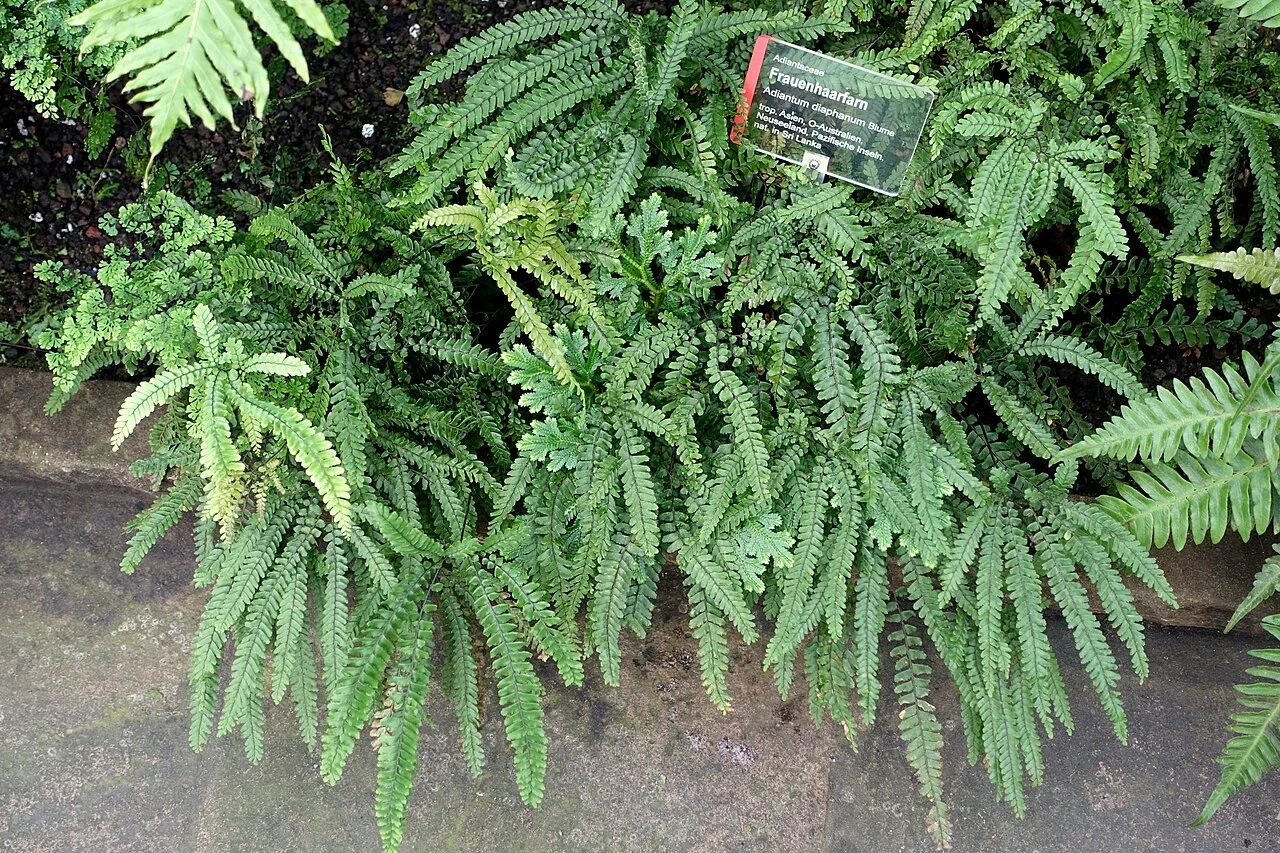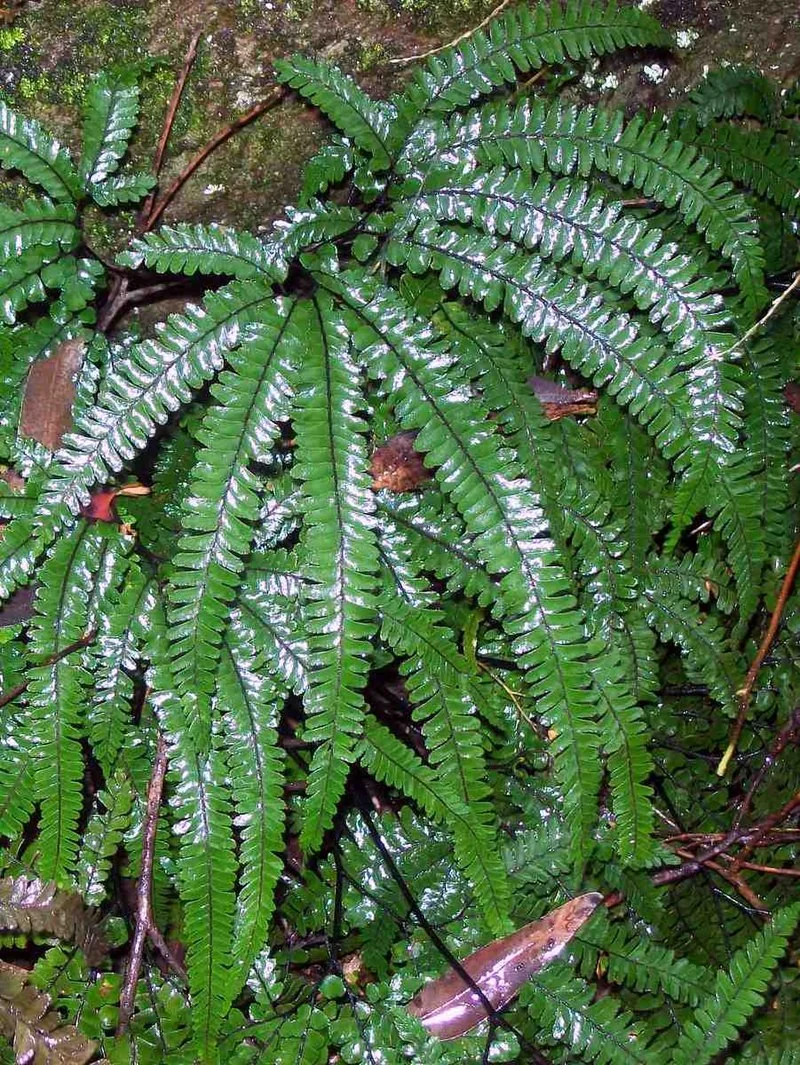
Small Maidenhair Fern
Adiantum diaphanum
Adiantum diaphanum , commonly known as Small Maidenhair Fern or filmy maidenhair, is New Zealand's smallest maidenhair fern species. This delicate indigenous fern is characterized by its translucent fronds that appear almost transparent when held against light, hence the name "diaphanum" meaning transparent. Growing to just 50-390mm tall, this rhizomatous perennial produces distinctive dark green fronds that are either simply pinnate or bi-pinnate, with small oblong segments attached at one corner. Found throughout the North and South Islands from Te Paki to Wellington, this graceful fern thrives in shaded forest environments under podocarp and broadleaved canopies.

Plant Description
Adiantum diaphanum is a delicate, small maidenhair forming low mats of fine, airy fronds 5-20 cm tall. Frond segments are thin and translucent with a neat, filigree texture; stipes are dark and wiry. In New Zealand it occurs mainly in warmer districts and on coastal rock faces.
Quick Facts
| Common Names | Small Maidenhair Fern, Filmy Maidenhair, Transparent Maidenhair |
|---|---|
| Scientific Name | Adiantum Diaphanum |
| Family | Pteridaceae (Maidenhair fern family) |
| Growth Form | Small rhizomatous perennial fern |
| Height | 50-390mm tall (smallest NZ maidenhair fern) |
| Spread | 20-30cm spreading via short rhizomes |
| Water Needs | High - requires consistent moisture and humidity |
| Light | Deep to partial shade - no direct sun |
| Frost Tolerance | Low - requires protection from frost |
| Salt Tolerance | Low - inland forest species, sensitive to salt |
| Growth Rate | Slow - patient establishment required |
| Lifespan | Long-lived perennial with proper care |
| Fronds | Dark green, herbaceous, 1-2 pinnate, translucent when backlit |
| Distinctive Features | Rootlets bear small tubers; single-corner segment attachment |
| Conservation Status | Not Threatened |
| Distribution | North and South Islands (Te Paki to Wellington) |
| Habitat | Shaded forest floor, streambanks, wet rocks, clay banks |
| Elevation Range | 5-275 m (primarily lowland) |
| Spore Season | Year-round in favorable conditions |
Climate Best Suited to
Best in frost-free to light-frost climates with consistent moisture and high humidity. Requires shade and shelter from drying wind.
Regional Suitability
| City | Climate Suitability |
|---|---|
| Whangārei | Ideal |
| Auckland | Ideal |
| Hamilton | Ideal |
| Tauranga | Ideal |
| Rotorua | Ideal |
| Gisborne | Ideal |
| New Plymouth | Ideal |
| Napier | Ideal |
| Whanganui | Ideal |
| Palmerston North | Ideal |
| Wellington | Ideal |
| Nelson | Ideal |
| Christchurch | Ideal |
| Dunedin | Ideal |
| Invercargill | Ideal |
Natural Habitat
Adiantum diaphanum occupies perpetually moist, shaded microhabitats such as forest banks, sandstone or limestone rock crevices, dripping clay faces, and sheltered coastal bluffs. It favours base‑rich or calcareous substrates with steady seepage, forming small patches among mosses and liverworts where humidity stays high and direct sun is excluded.
Plant Conservation
Conservation Status
Adiantum diaphanum has a conservation status of "Not Threatened" according to the New Zealand Threat Classification System. However, as an indigenous species with specific habitat requirements, it faces ongoing challenges from habitat modification and climate change impacts on forest ecosystems.
Ecological Importance
As New Zealand's smallest maidenhair fern, this species occupies a unique ecological niche in forest floor communities. Its presence indicates healthy, stable forest environments with appropriate moisture regimes and canopy cover. The species contributes to the diversity of New Zealand's pteridophyte flora and serves as an indicator of ecosystem integrity in lowland forest remnants.
The distinctive morphological features, including the tuber-bearing rootlets and translucent fronds, represent specialized adaptations to its shaded forest habitat. Conservation efforts focus on protecting remaining lowland forest fragments where this species naturally occurs, particularly in areas where forest clearance and urban development pose ongoing threats.
Growing Requirements
Soil
Moist, rich loam or clay. Often found on muddy banks.
Light
Full shade to dappled light. Scorches easily in sun.
Water
Needs constant moisture. High humidity is beneficial.
Planting Guide
Best Planting Practices
Plant divisions in spring into cool, shaded pockets; mulch with leaf litter and maintain humidity with frequent misting in summer.
Ecology
Stabilises damp rock faces and banks; provides micro-refugia for small invertebrates.
Fronds intercept fine moisture from mist and splash, maintaining a humid boundary layer on shaded rock. Spores disperse readily in moving air and can colonise tiny ledges, contributing to fern diversity in remnant lowland forest and coastal bluffs.
Uses
Exquisite fern for shaded troughs, rock crevices and terrariums in cool rooms.
Its minute scale and translucent pinnae make it ideal for bonsai-style rock displays and wardian cases; outdoors it excels in south-facing rockwork where gentle drip lines keep roots cool and evenly moist.
Landscaping Ideas
Plant in crevices of shaded stone walls with mosses and filmy ferns for a naturalistic look.
Pair with filmy ferns ( Hymenophyllum ) and Leptopteris near shaded water features to evoke damp gullies; include limestone chips in planting pockets for base‑loving companions.
Seasonal Care
Year-Round Tips
Keep well-watered during summer dry spells. In winter, you can trim back any tattered fronds to encourage fresh new croziers in spring. Mulch annually with leaf mould.
Pruning
Pruning Techniques
Remove tired fronds at the base to encourage fresh flushes.
Groom lightly through the season by pinching out browned segments; avoid hard shearing which weakens the fine rhizomes. Occasional thinning improves airflow and reduces scale and mealybug in still, indoor air.
How to Grow Small Maidenhair Fern
Small maidenhair is a diminutive fern that excels in cool, humid shade with even moisture and perfect drainage. Mimic its natural crevices and seepage sites by planting in a fine, humus-rich fern mix amended with pumice and fine bark, or tuck plants into shaded rockwork where water percolates but never puddles. Water frequently in small doses so the medium remains consistently moist without saturation. Use rainwater where possible to avoid mineral deposits on the delicate, translucent segments. Feed lightly with a dilute, balanced fertiliser during active growth, and shelter from wind and any direct sun that could scorch the fronds.
Spores
Collect ripe spores from the undersides of mature fronds and sow onto sterile, finely sieved fern media. Seal pots to maintain saturated humidity at 18-22°C in bright, indirect light. A green prothallus develops first; once tiny fronds appear, gradually increase ventilation and prick out to small pots. Keep evenly moist and shaded throughout establishment. Spore culture is slow but produces numerous plants true to type.
Division
Where small colonies have formed, gently divide the creeping rhizomes in spring, ensuring each piece carries active growth points. Replant shallowly into fresh mix, firm, water, and maintain high humidity until new fronds expand. Division is an efficient way to extend mats in troughs and shaded crevices.
Aftercare
Maintain constant humidity with grouped plantings or a humidity dome in very dry climates. Refresh leaf-litter mulch annually outdoors. Protect from slugs and snails that graze soft croziers. Browning or crisping tips indicate low humidity, excess light, or drought - adjust siting and watering accordingly.
Pests and Diseases
Common Problems and Solutions
Scale/mealybugs in dry air; snails graze tender fronds. Maintain humidity.
Frond tips crisping indicate low humidity or too much light; shift to cooler, deeper shade and increase humidity. Refresh potting mix yearly and avoid waterlogging to prevent root decline in cool conditions.
Cultural Significance
Traditional Uses and Values
Small Maidenhair Fern represents an important component of New Zealand's indigenous flora, embodying the delicate beauty and specialized adaptations of the country's forest understory communities. While specific traditional Māori uses for this particular species are not extensively documented, it forms part of the broader group of native ferns that held cultural significance.
The species name "diaphanum," meaning transparent or translucent, reflects its most distinctive characteristic - fronds that seem to glow when backlit, creating an ethereal presence in the forest understory. This quality has made it particularly valued by botanists and fern enthusiasts who appreciate its subtle beauty and challenging cultivation requirements.
As the smallest of New Zealand's maidenhair ferns, Adiantum diaphanum demonstrates the remarkable diversity within even small taxonomic groups in New Zealand's flora. Its presence in cultivation represents successful conservation of genetic diversity and provides opportunities for research into the specific requirements of threatened and challenging native species.
Bonus Tip
Expert Growing Advice
Use rainwater and avoid lime deposits on frondlets.
Stand pots on a pebble tray and cluster with other ferns to raise ambient humidity; ventilate terrariums weekly to prevent fungal issues while keeping conditions moist.







